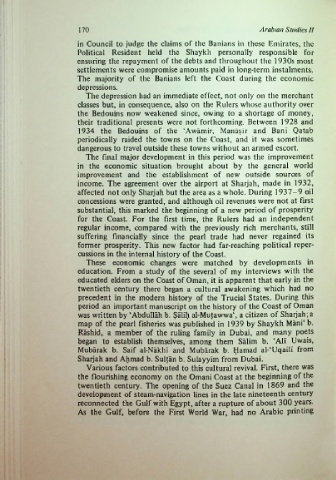Page 178 - Arabian Studies (II)
P. 178
170 Arabian Studies If
in Council to judge the claims of the Banians in these Emirates, the
Political Resident held the Shaykh personally responsible for
ensuring the repayment of the debts and throughout the 1930s most
settlements were compromise amounts paid in long-term instalments.
The majority of the Banians left the Coast during the economic
depressions.
The depression had an immediate effect, not only on the merchant
classes but, in consequence, also on the Rulers whose authority over
the Bedouins now weakened since, owing to a shortage of money,
their traditional presents were not forthcoming. Between 1928 and
1934 the Bedouins of the ‘Awamir, Manaslr and BanI Qatab
periodically raided the towns on the Coast, and it was sometimes
dangerous to travel outside these towns without an armed escort.
The final major development in this period was the improvement
in the economic situation brought about by the general world
improvement and the establishment of new outside sources of
income. The agreement over the airport at Sharjah, made in 1932,
affected not only Sharjah but the area as a whole. During 1937—9 oil
concessions were granted, and although oil revenues were not at first
substantial, this marked the beginning of a new period of prosperity
for the Coast. For the first time, the Rulers had an independent
regular income, compared with the previously rich merchants, still
suffering financially since the pearl trade had never regained its
former prosperity. This new factor had far-reaching political reper
cussions in the internal history of the Coast.
These economic changes were matched by developments in
education. From a study of the several of my interviews with the
educated elders on the Coast of Oman, it is apparent that early in the
twentieth century there began a cultural awakening which had no
precedent in the modern history of the Trucial States. During this
period an important manuscript on the history of the Coast of Oman
was written by ‘Abdullah b. Salih al-Mutawwa‘, a citizen of Sharjah; a
map of the pearl fisheries was published in 1939 by Shaykh Mani‘ b.
Rashid, a member of the ruling family in Dubai, and many poets
began to establish themselves, among them Salim b. ‘AIT Uwais,
Mubarak b. Saif al-Nakhl and Mubarak b. Hamad al-‘UqailI from
Sharjah and Ahmad b. Sultan b. Sulayyim from Dubai.
Various factors contributed to this cultural revival. First, there was
the flourishing economy on the Omani Coast at the beginning of the
twentieth century. The opening of the Suez Canal in 1869 and the
development of steam-navigation lines in the late nineteenth century
reconnected the Gulf with Egypt, after a rupture of about 300 years.
As the Gulf, before the First World War, had no Arabic printing

